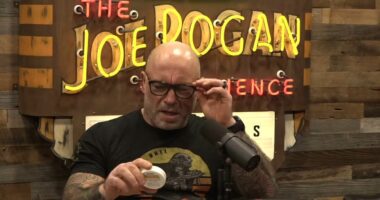Share this @internewscast.com
At just 19 years old, Nicole Sachs was told she would be wheelchair-bound by the time she was 40, unable to travel or have children.
Sachs had been suffering from debilitating lower back pain for years and was told by her doctor it was caused by spondylolisthesis, a spinal condition where a vertebra slips out of place.
Doctors insisted her pain was tied to the chronic spine condition, saying spinal fusion surgery was her best option, without guaranteeing it would put a stop to her pain for good.
But before she went through with it, she discovered the practice of mind-body work and something clicked: her pain stemmed not from a physical malady but repressed trauma and emotion.
Now, 30 years later not only is she pain-free, she’s a globe-trotting mother of three, defying the limitations once imposed on her.
In her book, Mind Your Body, Sachs, a social worker, reveals how she bridged the gap between traditional Western medicine and a radical new understanding of chronic pain: Her mind needed healing, not her spine.
Her journey challenges everything she thought she knew about pain.
Sachs writes it all started with a life-altering realization: doctors don’t always have all the answers. Now, she’s sharing the science behind the breakthrough that saved her, believing it could help millions trapped in unending pain.

Nicole Sachs, diagnosed with a lifelong spine disorder, reveals how she bridged the gap between traditional Western medicine and a radical new understanding of chronic pain : Her mind needed healing, not her spine
Pain can be all in your head, but not in the way you think.
For thousands of years, ancient healers believed the mind and body were inextricably linked – that grief could weaken the heart, stress could turn the stomach, and emotional trauma could manifest as physical pain.
The rise of Western medicine in the 17th century caused a seismic shift in the way people perceive pain and illness, seeing the body and mind as separate and to be treated as such.
This has culminated in millions of doctors telling their patients that all of their tests came back normal and their pain is all in their heads, which comes off as a dismissal.
That’s exactly how Sachs felt,.
Committing to the mind-body connection, however, reduced her suffering and sparked a quest to understand the brain’s role in chronic pain.
She pursued degrees in psychology and clinical social work and honed her approach, blending psychotherapy with mind-body science.
Sachs wrote: ‘The genesis of most chronic conditions can be explained when you understand the way a fight-or-flight-motivated nervous system sends signals of distress to divert us from the perceived “predators” causing our suffering… I have discovered over years of practice that this is what’s required to rewire your thinking.’
By giving voice to her inner child and unprocessed trauma, her pain began to dissolve.

Sachs shares her experience treating herself and many others in her new book Mind Your Body
In mind-body medicine, ‘chronic condition’ and ‘chronic pain’ cover a wide range of ongoing health issues, from autoimmune flare-ups and pain to GI problems, skin conditions, and anxiety.
Sachs dealt with severe back pain for years and was in and out of doctors’ offices, trying prescription painkillers and medications.
Your brain is hardwired to save you from danger, but when trapped in endless ‘fight-or-flight’ mode, it can turn emotional pain into chronic illness.
Stress floods your body with cortisol and adrenaline, preparing you to flee a predator or attempt to fight them off.
In mind-body medicine, pain isn’t random — it’s the nervous system’s way of distracting from repressed emotions like rage or heartbreak by converting them into physical symptoms.
The fix, Sachs says, is to stop fighting one’s feelings.
She herself dealt with deep loneliness, rage and injustices as a child.
As an adult, this triggered physical pain and she learned through mind-body science that her back pain was a response to that.
By confronting repressed emotions, patients can ‘switch off’ the body’s primal alarm system, stopping pain in its tracks.
As part of her practice, she created JournalSpeak — a raw, unfiltered journaling practice to release buried emotions.
JournalSpeak instructs people to choose a topic that is emotionally triggering to them and write about it for 20 minutes without worrying about spelling or grammar.
When completed, the person can burn, discard or delete the writings as the purpose is to purge, not reflect.
After writing, Sachs then instructs people to meditate or do grounding breathwork.
She wrote: ‘When the impolite, unthinkable truths are exhumed and safely felt, the nervous system no longer reacts by flying into protective mode and sending pain signals.’
Scientists have been wrestling with the idea that chronic pain is connected to emotional turmoil, and could even be a response to it.
A 2012 report in the journal Techniques in Regional Anesthesia and Pain Management concluded that chronic pain and emotional trauma are physiologically intertwined.
Researchers found 35 percent of chronic pain patients meet the criteria of a PTSD diagnosis.
Both conditions trigger hyperarousal in the amygdala and flood the body with stress hormones like cortisol.
In 2022, researchers from the University of California, Los Angeles, posited in the journal Neuroscience & Biobehavioral Reviews that repressed anger rewires the brain, activating the amygdala and flipping the ‘pain switch’ on to cause conditions like fibromyalgia and unexplained back pain.
Pent-up rage, they found, disrupts key brain regions, turning emotional stress into physical pain. Unprocessed trauma and anger keep that pain switch turned on and continuously weaken the prefrontal cortex, which regulates emotions, decision-making, and pain signals.
Sachs maintains the brain can learn to recognize that difficult emotions pose no real danger, reducing unnecessary pain signals, and techniques like JournalSpeak and mindfulness help recalibrate the nervous system, demonstrating that stress does not require a painful survival response.
















